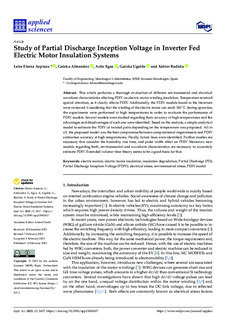
Izenburua
Study of Partial Discharge Inception Voltage in Inverter Fed Electric Motor Insulation SystemsBertsioa
Bertsio argitaratua
Eskubideak
© 2023 The AuthorsSarbidea
Sarbide irekiaArgitaratzailearen bertsioa
https://doi.org/10.3390/app13042417Non argitaratua
Applied Sciences Vol. 13. N. 4. N. artículo 2417Argitaratzailea
MDPIGako-hitzak
Electric motors
electric motor insulation
insulation degradation
Partial Discharge (PD) ... [+]
electric motor insulation
insulation degradation
Partial Discharge (PD) ... [+]
Electric motors
electric motor insulation
insulation degradation
Partial Discharge (PD)
Partial Discharge Inception Voltage (PDIV)
electrical stress
environmental stress
PDIV model
ODS 11 Ciudades y comunidades sostenibles
ODS 13 Acción por el clima [-]
electric motor insulation
insulation degradation
Partial Discharge (PD)
Partial Discharge Inception Voltage (PDIV)
electrical stress
environmental stress
PDIV model
ODS 11 Ciudades y comunidades sostenibles
ODS 13 Acción por el clima [-]
Laburpena
This article performs a thorough evaluation of different environmental and electrical waveform characteristics affecting PDIV on electric motor winding insulation. Temperature received special attenti ... [+]
This article performs a thorough evaluation of different environmental and electrical waveform characteristics affecting PDIV on electric motor winding insulation. Temperature received special attention, as it clearly affects PDIV. Additionally, the PDIV models found in the literature were reviewed. Considering that the winding of the electric motor can reach 180 ∘
C during operation, the experiments were performed at high temperatures in order to evaluate the performance of PDIV models. Several models were studied regarding their accuracy at high temperatures and the advantages and disadvantages of each one were identified. Based on the analysis, a simple analytical model to estimate the PDIV of twisted pairs depending on the temperature was proposed. All in all, the proposed model was the best compromise between computational requirements and PDIV estimation accuracy at high temperatures. Finally, future lines were identified. Further studies are necessary that consider the humidity, rise time, and pulse width effect on PDIV. Moreover, new models regarding both, environmental and waveform characteristics are necessary to accurately estimate PDIV. Extended volume–time theory seems to be a good basis for that. [-]
Sponsorship
Gobierno Vasco-Eusko JaurlaritzaProjectu ID
info:eu-repo/grantAgreement/GV/Elkartek 2021/KK-2021-00044/CAPV/Vehículo eléctrico basado en Nitruro de Galio/VEGANBildumak
Item honek honako baimen-fitxategi hauek dauzka asoziatuta:






















